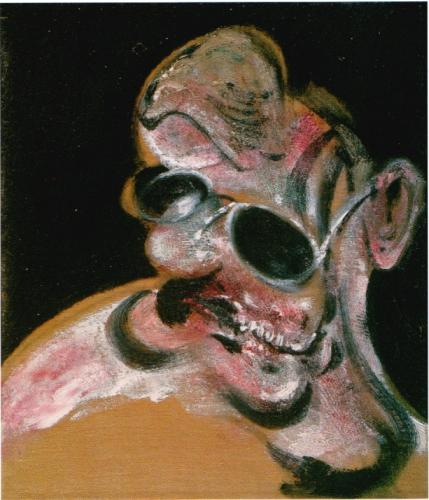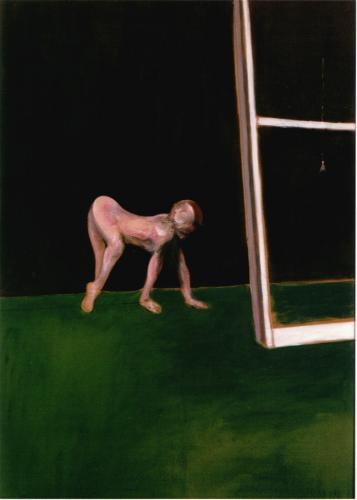-
Par MMaxi le 15 March 2007 à 20:55

" Well, of course, we are meat, we are potencial carcasses. If I go into a butcher's shop I always think it's surprising that I wasn't there instead of the animal."
Francis Bacon
-
-
Par MMaxi le 28 February 2007 à 16:20

Paralytic Child Walking on All Fours (from Muybridge), 1961
Francis Bacon
In Paralytic Child Walking on All Fours (from Muybridge), a naked body on hands and feet is finding its way around a bare space. Human or animal? The ambiguity creates tension and confronts the viewer with the awkwardness of the figure. Paralytic Child… is inspired by Muybridge's shocking but fascinating series of photographs of a crippled child. Francis Bacon has turned the image into a poignant but serene painting. Bacon gives only subtle hints of the nature of the space around the child is moving. One green and one black plane, separated from each other by an ultra-fine strip of unpainted canvas, indicate the wall and floor. On the right, a framework leans against the black plane. It is reminiscent both of a stretcher for canvas and a doorframe. In this picture it creates an illusion of depth and lends direction to the movement of the child.
-
Par MMaxi le 28 February 2007 à 15:18

Henrietta Moraes
From the 1960s on, Bacon regularly painted portraits of his drinking cronies. Moraes said she had been the subject of more than twenty, including the 1969 triptych entitled Three Studies of Henrietta Moraes. Bacon met Henrietta Moraes at the Colony Room, the bar in Soho (London) where he was accustomed to meet his artistic and other friends from the 1960s on. In an interview, Moraes was later to say that she hung around the pub specially in the hope of being noticed by Bacon. And that is what happened. She attracted attention by her vitality, riotous laughter and unruly behaviour. She quickly became part of Bacon's circle, which also included the photographer John Deakin. He was commissioned by Bacon to conduct a number of photo sessions with Henrietta Moraes, including a series of her lying nude on a bed, in the same pose shown in the painting Untitled (Reclining Woman), of which he had already painted a number of versions.
-
Par MMaxi le 27 February 2007 à 13:07

Isabel Rawsthorne (1912 - 1992)
also known as Isabel Lambert, was a model and painter.
Isabel Nichols was born in the east end of London, but brought up in Liverpool where she studied at the Liverpool School of Art. Jacob Epstein used her as a model in the early thirties (the bronze bust "Isabel" 1933). Her second husband was Sefton Delmer, a journalist. They lived in Paris, and there she became a model for Giacometti and Picasso. By 1945 this relationship had broken down. Her third husband was composer Constant Lambert. She painted set scenery for his last work, the ballet Tiresias, created for the Festival of Britain. They married in 1947, but he died in 1951. In 1952 she married another composer Alan Rawsthorne, a drinking friend of Constant Lambert. Isabel then became a model for Francis Bacon. He was a noted homosexual, yet according to Paris Match, Francis Bacon said "You know, I also made love to Isabel Rawsthorne, a very beautiful woman who was Derain's model and Georges Bataille's girlfriend.". His most famous portrait of her is "Three Studies of Isabel Rawsthorne" (1966). According to Norman Lebrecht, she "matched her husbands for drink, swore like a navvy and was a fine painter besides". Her early works do not survive, but she was painting in a neo-Romantic style while married to Constant Lambert. She painted skeletons of birds, and later ballet dancers.
-
Par MMaxi le 21 February 2007 à 12:09

Francis Bacon
From muybridge " The Human Figure in Motion: Women Emptying a bowl of water / Paralytic child walking on all fours."
-
Par MMaxi le 19 February 2007 à 18:02

Francis Bacon once said:
" I think it's the slight remove from fact, which returns me onto the fact more violently.
Through the photographic image I find myself beginning to wander into the image and unlock what I think of as its reality more than I can by looking at it.
And photographs are only points of reference; They're often triggers of ideas."
-
Par MMaxi le 16 February 2007 à 10:47

Study for Portrait on Folding Bed 1963
Oil on canvas
support: 1981 x 1473 mm frame: 2198 x 1690 x 82 mm
painting
Purchased 1963
The body is often highly distorted in Bacon’s paintings. In this picture, for example, parts of the head and lower body are almost illegible. Bacon has used texture and visceral colours to describe the flesh, bone and blood of the head. The dribbles and splatters of paint are reminiscent of leaking bodily fluids, bringing attention to the physical material of the body and suggesting violence.
The art historian David Mellor has argued that such pictures share much with Walter Sickert’s Camden Town paintings of prostitutes on beds ‘where gross, abject matter was well to the fore’.
-
-
Par MMaxi le 13 February 2007 à 14:20

Painting Title: Study for a Portrait of Van Gogh V 1957
Francis Bacon
Famous Irish born English artist - 20th Century Painter
About the Study for a Portrait of Van Gogh V Painting
Francis Bacon did several versions of the Vincent van Gogh painting.
 Follow this section's article RSS flux
Follow this section's article RSS flux
MMaxi Madeiraman




